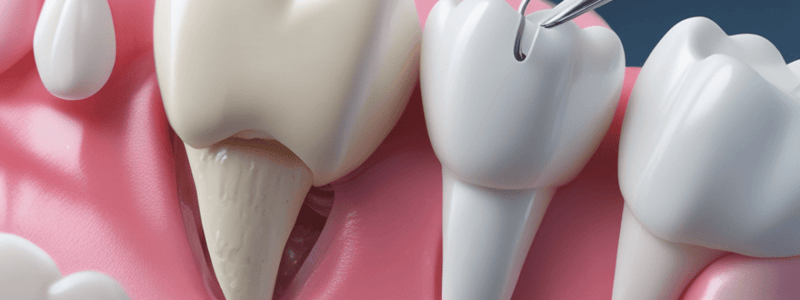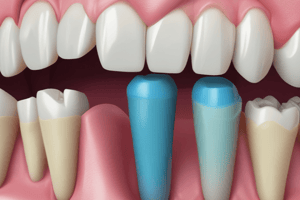Podcast
Questions and Answers
What is the primary objective of tooth preparation?
What is the primary objective of tooth preparation?
- To remove all defects and protect the pulp
- To form the tooth preparation so that the tooth or restoration will not fracture under mastication forces
- To allow for the esthetic and functional placement of a restorative material
- All of the above (correct)
Which wall of the cavity is formed only by dentin?
Which wall of the cavity is formed only by dentin?
- Pulpal wall (correct)
- External wall
- Internal wall
- Axial wall
What is the purpose of the external wall of the cavity preparation?
What is the purpose of the external wall of the cavity preparation?
- To be parallel to the long axis of the tooth
- To extend the prepared surface to the external tooth surface (correct)
- To be perpendicular to the long axis of the tooth
- To provide protection to the pulp
What is the primary function of the axial wall in a tooth preparation?
What is the primary function of the axial wall in a tooth preparation?
What is the purpose of the internal walls in a tooth preparation?
What is the purpose of the internal walls in a tooth preparation?
Which step in tooth preparation is considered the initial step?
Which step in tooth preparation is considered the initial step?
What is the purpose of the pulpal wall in a tooth preparation?
What is the purpose of the pulpal wall in a tooth preparation?
Which tooth structure forms the walls of the cavity, except for the pulpal floor?
Which tooth structure forms the walls of the cavity, except for the pulpal floor?
What is the main purpose of the initial tooth preparation stage STEP 2: PRIMARY RESISTANCE FORM?
What is the main purpose of the initial tooth preparation stage STEP 2: PRIMARY RESISTANCE FORM?
Why is it important to have a slight rounding of internal line angles in the tooth preparation?
Why is it important to have a slight rounding of internal line angles in the tooth preparation?
What is the purpose of rounding the external (axiopulpal) line angles within the tooth preparation?
What is the purpose of rounding the external (axiopulpal) line angles within the tooth preparation?
What is the typical feature of the initial depth of the tooth preparation?
What is the typical feature of the initial depth of the tooth preparation?
Which of the following is NOT a typical feature of establishing proper outline form and initial depth in the tooth preparation?
Which of the following is NOT a typical feature of establishing proper outline form and initial depth in the tooth preparation?
How does connecting two close features help the tooth resist occlusal loading?
How does connecting two close features help the tooth resist occlusal loading?
What is the purpose of restricting the extension of the external walls in the tooth preparation?
What is the purpose of restricting the extension of the external walls in the tooth preparation?
What is the main purpose of the initial tooth preparation stage?
What is the main purpose of the initial tooth preparation stage?
What is the cavosurface angle?
What is the cavosurface angle?
What is an external line angle?
What is an external line angle?
What is the purpose of the initial tooth preparation stage?
What is the purpose of the initial tooth preparation stage?
What should be done to resist fracture of the tooth or restorative material from masticatory forces?
What should be done to resist fracture of the tooth or restorative material from masticatory forces?
What is an internal line angle?
What is an internal line angle?
Which principle involves extending the restoration conservatively?
Which principle involves extending the restoration conservatively?
What does a point angle represent?
What does a point angle represent?
Which stage involves cleaning of the cavity?
Which stage involves cleaning of the cavity?
What is the purpose of reducing and covering weak cusps during initial tooth preparation in extensive tooth preparations?
What is the purpose of reducing and covering weak cusps during initial tooth preparation in extensive tooth preparations?
When should cusp reduction be considered during initial tooth preparation according to the text?
When should cusp reduction be considered during initial tooth preparation according to the text?
What is the minimal occlusal thickness for amalgam needed for appropriate resistance to fracture according to the text?
What is the minimal occlusal thickness for amalgam needed for appropriate resistance to fracture according to the text?
Which design feature enhances primary resistance form during tooth preparation?
Which design feature enhances primary resistance form during tooth preparation?
What is recommended for internal line angles during tooth preparation to enhance primary resistance form?
What is recommended for internal line angles during tooth preparation to enhance primary resistance form?
In what shape should the gingival wall (floor) be prepared in the proximal portion of conventional Class II preparations?
In what shape should the gingival wall (floor) be prepared in the proximal portion of conventional Class II preparations?
What should be included within the restoration in extensive tooth preparations according to the text?
What should be included within the restoration in extensive tooth preparations according to the text?
What guides the reduction of cusps during initial tooth preparation?
What guides the reduction of cusps during initial tooth preparation?
What is the primary purpose of the primary retention form in tooth preparation?
What is the primary purpose of the primary retention form in tooth preparation?
How does the primary retention form differ between amalgam and composite restorations?
How does the primary retention form differ between amalgam and composite restorations?
What is the main purpose of the convenience form in tooth preparation?
What is the main purpose of the convenience form in tooth preparation?
What is an example of a convenience form procedure?
What is an example of a convenience form procedure?
Which of the following is NOT a principle of the primary retention form?
Which of the following is NOT a principle of the primary retention form?
What is the main difference between the primary retention form and the convenience form in tooth preparation?
What is the main difference between the primary retention form and the convenience form in tooth preparation?
Which of the following is NOT a principle of the primary retention form for amalgam restorations?
Which of the following is NOT a principle of the primary retention form for amalgam restorations?
What is the primary purpose of the micromechanical bond in composite restorations?
What is the primary purpose of the micromechanical bond in composite restorations?
How does the convenience form differ between amalgam and composite restorations?
How does the convenience form differ between amalgam and composite restorations?
What is the main difference between the primary retention form and the convenience form in terms of their objectives?
What is the main difference between the primary retention form and the convenience form in terms of their objectives?
Flashcards are hidden until you start studying



